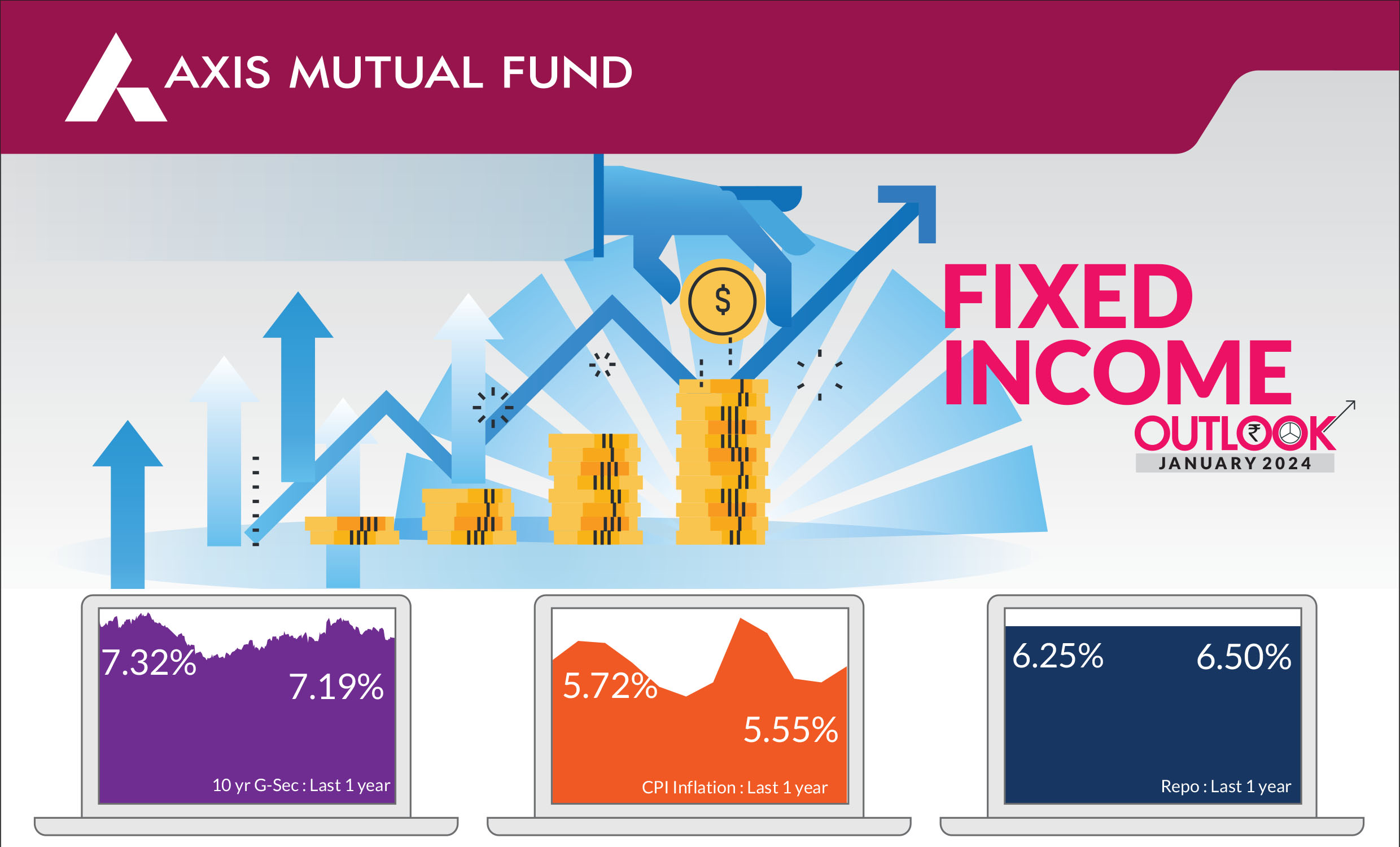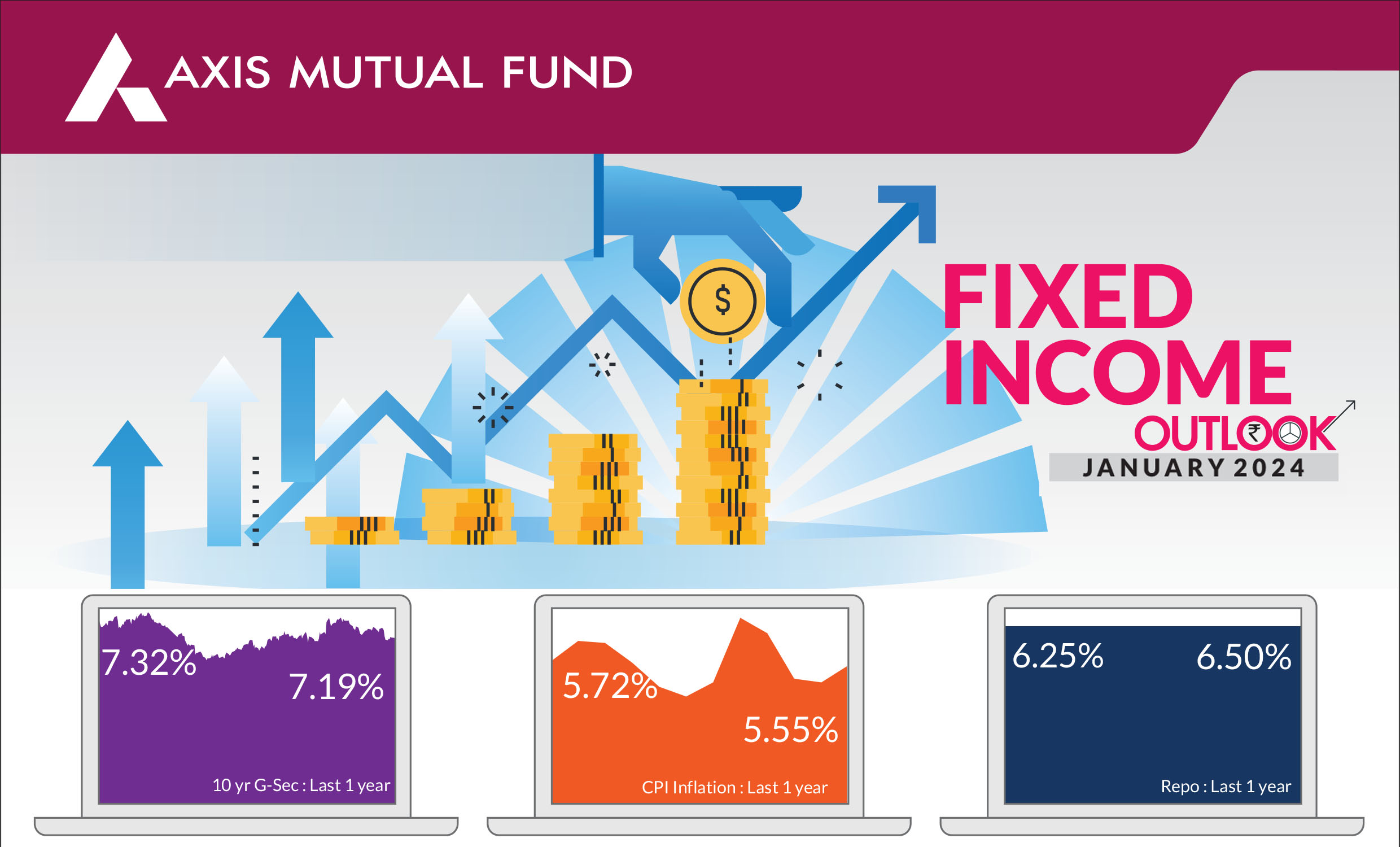•
Interest rate cycles have
peaked both globally and in
India.
• Investors should add duration
with every rise in yields.
•
Mix of 10-year duration and
2-4-year duration assets are
best strategies to invest in the
current macro environment.
•
Credits continue to remain
attractive from a risk reward
perspective given the improving
macro fundamentals.
Indian government bond yields fell over the month, trading in a narrow band of 7.16-7.29% and ending at 7.19%. The key factors driving the bond markets were a fall in US Treasury yields, and expectations that the central banks across the globe would start lowering interest rates in the second half of 2024.
► US Treasury yields retreat over
the month:
US Treasury yields
ended further lower in December
amid increasing optimism that the
Federal Reserve (Fed) will keep
interest rates on hold and may
lower them in the second half of
the next year. The yields on the 10-
year Treasury fell to 3.9%, a significant decline of 50 bps from previous
month's close of 4.3%. Meanwhile, the yields on the 2 year Treasuries fell
marginally lesser than the longer end leading to the yield curve getting less
inverted to flat. In its December policy meeting, the Fed maintained rates on
hold. Alongside its interest rate decision, the Fed also upgraded its growth
outlook for this year and reduced it for 2024. It cut its inflation outlook for
both years as well. Members of the Federal Open Market Committee also
cut the median projection for interest rates at end-2024 to the midpoint
between 4.50 and 4.75. This signals they now expect 0.75 percentage points
of cuts.

► Inflationary pressures and oil prices head lower:
Headline inflation rose to
5.6% in November 2023, led by increase in food price, after falling below 5%
in the previous month. Nevertheless, core inflation stood at 4.1% and
continues to maintain downward momentum. As widely expected, the
Reserve Bank of India (RBI) remained on hold in its December monetary
policy meeting. Crude oil prices inched to $73 levels but ended down 7% at
$77. Crude rose from its December low as Houthi attacks on vessels in the
Red Sea forced tankers and other ships to divert on longer voyages, boosting
costs. Nonetheless, in 2023, crude declined 10% due to geopolitical conflict
in the Middle East and concerns about the oil output levels of major
producers around the world.
► Macro indicators remain favourable: Domestic demand remained robust even as there were signs of moderation in November driven by the festivalrelated holiday impact. Industrial production in October registered a robust growth at 11.7% compared with an upwardly revised 6.2% reading in September, aided by a favorable base effect and pre-festive sequential pickup. Manufacturing sector grew 10.4% while consumer durables and consumer non-durables grew 15.9% and 8.6% respectively. PMI manufacturing rose to 56 in November from 55.5 in October, remaining in expansionary zone since July 2021. Meanwhile, credit growth rose to 16.3% in November from 15.3% in October.
► Macro indicators remain favourable: Domestic demand remained robust even as there were signs of moderation in November driven by the festivalrelated holiday impact. Industrial production in October registered a robust growth at 11.7% compared with an upwardly revised 6.2% reading in September, aided by a favorable base effect and pre-festive sequential pickup. Manufacturing sector grew 10.4% while consumer durables and consumer non-durables grew 15.9% and 8.6% respectively. PMI manufacturing rose to 56 in November from 55.5 in October, remaining in expansionary zone since July 2021. Meanwhile, credit growth rose to 16.3% in November from 15.3% in October.
Market view
Finally, a pause in the developed economies and policy speak by the central banks suggests that interest rates have peaked globally. In the US, the economy is beginning to show signs of moderation despite a stronger than expected economic growth. Given the Fed's projections, markets are already anticipating the rate cuts and yields have come off more than 120 bps from the highs of 5%.On the domestic front, as we had expected, the RBI remained on hold and is expected to be on hold at least till June 2024. With fiscal consolidation on course, external balance remaining eminently manageable and forex reserves providing cushion against external shocks - Indian economy does remain strong. Consequently, the central bank further raised the growth forecast for the year from 6.5% to 7% and remained confident of robust growth. Even though the RBI expects slightly higher numbers in November and December, it is not meaningfully worried and expects inflation to head lower over the next one year. The RBI believes that the transmission of the previous rate hikes is still an ongoing process. If inflation is 4% by Sep 2024 as is the forecast, we could see market expectations around future policy build up in that time frame.
We believe, the RBI has already engineered a rate hike in last 3 months by moving the operative rate from 6.5-6.75% by keeping banking liquidity extremely tight. We believe as financial conditions globally and pressures on the rupee have significantly eased, RBI will ease its liquidity stance to Neutral from tight in February or April monetary policy which would lead to 15-20 bps of rally in our markets. We believe that RBI will cut rates only after Real rate goes above 2%. Our belief is that the central banks of developed markets would be more aggressive in cutting rates as compared to those in emerging markets.
Most part of the fixed income curve is pricing in cuts only after June 2024. With policy rates remaining incrementally stable, we have retained our long duration stance across our portfolios within the respective scheme mandates. We do expect the 10-year bond yields to touch 6.75% by April - June 2024.
From a strategy perspective, we continue to add duration across portfolios within the respective investment mandates. We expect our duration call to add value in the medium term. Investors could use this opportunity to top up on duration products with a structural allocation to short and medium duration funds and a tactical play on GILT funds.
Source: Bloomberg, Axis MF Research.


